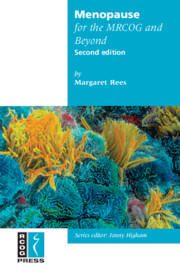Book contents
- Frontmatter
- Contents
- Preface
- Abbreviations
- 1 Definitions and controversies
- 2 Explaining risk
- 3 Systemic hormone replacement therapy
- 4 Non-HRT options for osteoporosis
- 5 Diet and lifestyle
- 6 Alternative and complementary therapies
- 7 Vasomotor symptoms, urogenital and sexual problems
- 8 Osteoporosis and autoimmune arthritis
- 9 Breast disease
- 10 Benign and malignant gynaecological disease
- 11 Premature menopause
- 12 Women with concomitant medical conditions
- Index
2 - Explaining risk
Published online by Cambridge University Press: 05 July 2014
- Frontmatter
- Contents
- Preface
- Abbreviations
- 1 Definitions and controversies
- 2 Explaining risk
- 3 Systemic hormone replacement therapy
- 4 Non-HRT options for osteoporosis
- 5 Diet and lifestyle
- 6 Alternative and complementary therapies
- 7 Vasomotor symptoms, urogenital and sexual problems
- 8 Osteoporosis and autoimmune arthritis
- 9 Breast disease
- 10 Benign and malignant gynaecological disease
- 11 Premature menopause
- 12 Women with concomitant medical conditions
- Index
Summary
Women may be concerned about the risks of any particular treatment and, in the case of menopausal women, HRT in particular. This has not been helped by media scares. This chapter focuses on how to explain risk and the risks in certain clinical situations.
Relative risk, absolute risk, attributable risk
The terms ‘relative risk’, ‘absolute risk’ and ‘attributable risk’ can be confusing. An understanding of the precise definitions is important to judge the actual magnitude of risks involved.
Relative risk (RR) is the risk of an event (or of developing a disease) relative to exposure. Relative risk is a ratio of the probability of the event occurring in the exposed group versus the control (non-exposed) group. It is often used to present clinical trial data, where it is used to compare the risk of developing a disease in people receiving a treatment compared with those not receiving treatment (or receiving a placebo). However, it does not take into account the actual frequency of the condition in the untreated group. For example, a relative risk of 2 could describe something that increased the risk of a disease from one in a million to two in a million or something that increased the risk of a disease from four people in ten to eight people in ten. Thus ‘absolute risk’ and ‘attributable risk’, which take into account the frequency of the condition, are better methods of presenting the data.
- Type
- Chapter
- Information
- Menopause for the MRCOG and Beyond , pp. 9 - 16Publisher: Cambridge University PressPrint publication year: 2008

